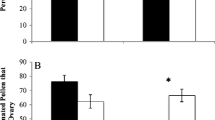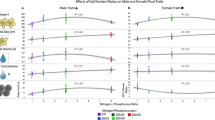Abstract
Hyperaccumulation is the phenomenon whereby plants take up and sequester in high concentrations elements that generally are excluded from above-ground tissues. It largely is unknown whether the metals taken up by these plants are transferred to floral rewards (i.e., nectar and pollen) and, if so, whether floral visitation is affected. We grew Streptanthus polygaloides, a nickel (Ni) hyperaccumulator, in short-term Ni supplemented soils and control soils to determine whether Ni is accumulated in floral rewards and whether floral visitation is affected by growth in Ni-rich soils. We found that while supplementation of soils with Ni did not alter floral morphology or reward quantity (i.e., anther size or nectar volume), Ni did accumulate in the nectar and pollen-filled anthers—providing the first demonstration that Ni is accumulated in pollinator rewards. Further, S. polygaloides grown in Ni-supplemented soils received fewer visits per flower per hour from both bees and flies (both naïve to Ni-rich floral resources in the study area) relative to plants grown in control soils, although the probability a plant was visited initially was unaffected by Ni treatment. Our findings show that while Ni-rich floral rewards decrease floral visitation, floral visitors are not completely deterred, so some floral visitors may collect and ingest potentially toxic resources from metal-hyperaccumulating plants. In addition to broadening our understanding of the effects of metal accumulation on ecological interactions in natural populations, these results have implications for the use of insect-pollinated plants in phytoremediation.


Similar content being viewed by others
References
Adler LS (2001) The ecological significance of toxic nectar. Oikos 91:409–420
Alexander EB, Coleman RG, Keeler-Wolf T, Harrison SP (2007) Serpentine geoecology of Western North America. Oxford University Press, New York
Bahadorani S, Hilliker AJ (2009) Biological and behavioral effects of heavy metals in Drosophila melanogaster adults and larvae. J Insect Behav 22:399–411
Baker I (1979) Methods for the determination of volumes and sugar concentrations from nectar spots on paper. Phytochem Bull 12:40–42
Baker AJM, Brooks RR (1989) Terrestrial higher plants which hyper accumulate metallic elements- review of their distribution, ecology and phytochemistry. Biorecovery 1:81–126
Baldwin BG, Goldman DH, Keil DJ, Patterson R, Rosatti TJ, Wilken DH (eds) (2012) The Jepson manual: vascular plants of California. University of California Press, Berkeley
Behmer ST, Llloyd CM, Raubenheimer D, Stewart-Clark J, Knight J, Leighton RS, Herper FA, Smith JAC (2005) Metal hyperaccumulation in plants: mechanisms of defence against insect herbivores. Funct Ecol 19:55–66
Bhowmik S, Datta BK (2013) Pollen production in relation to ecological class of some hydrophytes and marsh plants. Am J Plant Sci 4:324–332
Boyd RS (2004) Ecology of metal hyperaccumulation. New Phytol 162:563–567
Boyd RS, Jhee EM (2005) A test of elemental defense against slugs by Ni in hyperaccumulator and non-hyperaccumulator Streptanthus species. Chemoecology 15:179–185
Boyd RS, Martens SN (1992) The raison d’etre for metal hyperaccumulation by plants. In: Baker AJM, Proctor J, Reeves RD (eds) The vegetation of ultramafic (Serpentine) soils. Intercept, GB-Andover, pp 279–289
Boyd RS, Martens SN (1994) Nickel hyperaccumulated by Thlaspi montanum var. montanum is cutely toxic to an insect herbivore. Oikos 70:21–25
Boyd RS, Davis MA, Wall MA, Balkwill K (2002) Nickel defends the South African hyperaccumulator Senecio coronotus (Asteraceae) against Helix aspersa (Molluska: Pulmonidae). Chemoecology 12:91–97
Brun LA, Le Corff J, Mallet J (2003) Effects of elevated copper on phenology, growth and reproduction of five ruderal plant species. Environ Pollut 122:361–368
Burkle LA, Irwin RE (2010) Beyond biomass: measuring the effects of community-level nitrogen enrichment on floral traits, pollinator visitation and plant reproduction. J Ecol 98:705–717
Chardot V, Massoura ST, Echevarria G, Morel JL (2005) Phytoextraction of the nickel hyperaccumulators Leptoplax emarginata and Bornmuellera tymphaea. Int J Phytoremediat 7:323–335
Chen Y, Shen Z, Li X (2004) The use of vetiver grass (Vetiveria zizanioides) in the phytoremediation of soils contaminated with heavy metals. Appl Geochem 19:1553–1565
Cheruiyot DJ, Boyd RS, Moar WJ (2013) Exploring the lower limits of plant elemental defense by cobalt, copper, nickel, and zinc. J Chem Ecol 39:666–674
Coleman CM, Boyd RS, Eubanks MD (2005) Extending the elemental defense hypothesis: dietary metal concentrations below hyperaccumulator levels could harm herbivores. J Chem Ecol 31:1669–1681
de Brito Sanchez G, Giurfa M (2011) A comparative analysis of neural taste processing in animals. Philos Trans R Soc 366:2171–2180
de Brito Sanchez G, Ortigão-Farias J, Gauthier M, Liu F, Giurfa M (2007) Taste perception in honeybees: just a taste of honey? Arthropod-Plant Interactions 1:69–76
Gegear RJ, Manson JS, Thomson JD (2007) Ecological context influences pollinator deterrence by alkaloids in floral nectar. Ecol Lett 10:375–382
Gerhardt KE, Huang X-D, Glick BR, Greenberg BM (2009) Phytoremediation and rhizoremediation of organic soil contaminants: potential and challenges. Plant Sci 176:20–30
Hladun KR, Smith BH, Mustard JA, Morton RR, Trumble JT (2012) Selenium toxicity to honey bee (Apis mellifera L.) pollinators: effects on behaviors and survival. PLoS ONE 7:e34137
Hladun KR, Parker DR, Tran KD, Trumble JT (2013) Effects of selenium accumulation on phytotoxicity, herbivory, and pollination ecology in radish (Raphanus sativus L.). Environ Pollut 172:70–75
Irwin RE, Adler LS (2008) Nectar secondary compounds affect self-pollen transfer: implications for female and male reproduction. Ecology 89:2207–2217
Kearns CA, Inouye DW (1993) Techniques for pollination biologists. University Press of Colorado, Niwot
Kramer U, Smith RD, Wenzel WW, Raskin I, Salt DE (1997) The role of metal transport and tolerance in nickel hyperaccumulation by Thlaspi goesingense Halacsy. Plant Physiol 115:1641–1650
L’Huillier L, Edighoffer S (1996) Extractability of nickel and its concentration in cultivated plants in Ni rich ultramafic soils of New Caledonia. Plant Soil 186:255–264
Lapanje A, Zrimec A, Drobne D, Rupnik M (2010) Long-term Hg pollution-induced structural shifts of bacterial community in the terrestrial isopod (Porcellio scaber) gut. Environ Pollut 158:3186–3193
Leyval C, Turnau K, Haselwandter K (1997) Effect of heavy metal pollution on mycorrhizal colonisation and function, physiological, ecological and applied aspects. Mycorrhiza 7:139–153
Li Y-M, Chaney R, Brewer E, Roseberg R, Angle JS, Baker A, Reeves R, Nelkin J (2003) Development of a technology for commercial phytoextraction of nickel: economic and technical considerations. Plant Soil 249:107–115
Masierowska ML (2003) Floral nectaries and nectar production in brown mustard (Brassica juncea) and white mustard (Sinapis alba) (Brassicaceae). Plant Syst Evol 238:97–107
Meindl GA, Ashman T-L (2013) The effects of nickel and aluminum on the foraging behavior of bumblebees. Environ Pollut 177:78–81
Mitchell RJ, Karron JD, Holmquist KG, Bell JM (2004) The influence of Mimulus ringens floral display size on pollinator visitation patterns. Funct Ecol 18:116–124
Mogren CL, Trumble JT (2010) The impacts of metals and metalloids on insect behavior. Entomol Exp Appl 135:1–17
Pilon-Smits E (2005) Phytoremediation. Annu Rev Plant Biol 56:15–39
Preston RE (1991) The intrafloral phenology of Streptanthus tortuosus (Brassicaceae). Am J Bot 78:1044–1053
Quinn CF, Prins CN, Freeman JL, Gross AM, Hantzis LJ, Reynolds R, Yang S, Covey PA, Banuelos GS, Pickering IJ, Fakra SC, Marcus MA, Arathi HS, Pilon-Smits AH (2011) Selenium accumulation in flowers and its effects on pollination. New Phytol 192:727–737
Rathinasabapathi B, Rangasamy M, Froeba J, Cherry RH, McAuslane HJ, Capinera JL, Srivastava M, Ma LQ (2007) Arsenic hyperaccumulation in the Chinese brake fern (Pteris vittata) deters grasshopper (Schistocerca americana) herbivory. New Phytol 175:363–369
Reeves RD (2006) Hyperaccumulation of trace elements by plants. In: Morel JL, Echevarria G, Goncharova N (eds) Phytoremediation of metal-contaminated soils, vol 68. Springer, New York
Reeves RD, Baker AJM (2000) Metal-accumulating plants. In: Raskin I, Ensley BD (eds) Phytoremediation of toxic metals: using plants to clean up the environment. John Wiley and Sons, New York
Reeves RD, Brooks RR, Macfarlane RM (1981) Nickel uptake by Californian Streptanthus and Caulanthus with particular reference to the hyperaccumulator S. polygaloides Gray (Brassicaceae). Am J Bot 68:708–712
Saikkonen K, Koivunen S, Vuorisalo T, Mutikainen P (1998) Interactive effects of pollination and heavy metals on resource allocation in Potentilla anserina L. Ecology 79:1620–1629
Sarma H (2011) Metal hyperaccumulation in plants: a review focusing on phytoremediation technology. J Environ Sci Technol 4:118–138
Slomka A, Jerdrzejczyk-Korycinska M, Rotanski A, Karcz J, Kawalec P, Kuta E (2012) Heavy metals in sol affect reproductive processes more than morphological characters in Viola tricolor. Environ Exp Bot 75:204–211
van der Ent A, Baker AJM, Reeves RD, Pollard AJ, Schat H (2013) Hypraccumulators of metal and metalloid trace elements: facts and fiction. Plant Soil 362:319–334
Vesk PA, Reichman S (2009) Hyperaccumulators and herbivores—A Bayesian meta-analysis of feeding choice trials. J Chem Ecol 35:289–296
Vogel-Mikus K, Drobne D, Regvar M (2005) Zn, Cd, and Pb accumulation and arbuscular mycorrhizal colonization of pennycress Thlaspi praecox Wulf. (Brassicaceae) from the vicinity of a lead mine and smelter in Slovenia. Environ Pollut 133:233–242
Wall MA, Boyd RS (2002) Nickel accumulation in serpentine arthropods from the Red Hills, California. Pan Pac Entomol 78:168–176
Zhu Y-G, Pilon-Smits EAH, Zhao F-J, Williams PN, Meharg AA (2009) Selenium in higher plants: understanding mechanisms for biofortification and phytoremediation. Trends Plant Sci 14:436–442
Acknowledgments
We thank R. Boyd, J. Wenzel, and D. Bain for technical support, E. York for greenhouse assistance, M. Koski and three anonymous reviewers for comments on a previous version of this manuscript, and members of the Ashman lab for discussion. Funding was provided by the Powdermill Nature Reserve, a Botany In Action Fellowship from the Phipps Conservatory and Botanical Gardens, an Ivy McManus Diversity Fellowship (University of Pittsburgh) and an Andrew Mellon Predoctoral Fellowship (University of Pittsburgh) to GAM, and NSF (DEB 1020523) to TLA.
Author information
Authors and Affiliations
Corresponding author
Rights and permissions
About this article
Cite this article
Meindl, G.A., Ashman, TL. Nickel Accumulation by Streptanthus polygaloides (Brassicaceae) Reduces Floral Visitation Rate. J Chem Ecol 40, 128–135 (2014). https://doi.org/10.1007/s10886-014-0380-x
Received:
Revised:
Accepted:
Published:
Issue Date:
DOI: https://doi.org/10.1007/s10886-014-0380-x




